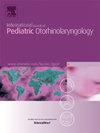Construction of a nomogram for individualized prediction of obstructive sleep apnea syndrome risk in snoring children
IF 1.2
4区 医学
Q3 OTORHINOLARYNGOLOGY
International journal of pediatric otorhinolaryngology
Pub Date : 2025-06-13
DOI:10.1016/j.ijporl.2025.112431
引用次数: 0
Abstract
Objective
To develop and validate a nomogram for the individualized prediction of obstructive sleep apnea syndrome (OSAS) risk in children presenting with snoring.
Methods
This retrospective study included 294 children with snoring admitted to our hospital between November 2022 and November 2024. Patients were randomly allocated into a modeling group (n = 206) and a validation group (n = 88). Based on the diagnosis of OSAS, patients in each group were further categorized into OSAS and non-OSAS subgroups. Logistic regression analysis was employed to identify independent risk factors for OSAS. R software was utilized to construct the nomogram. The model's discrimination was assessed using the Receiver Operating Characteristic (ROC) curve and Area Under the Curve (AUC). Calibration was evaluated using the Hosmer-Lemeshow (H-L) test. Decision Curve Analysis (DCA) was performed to determine the clinical utility of the nomogram.
Results
Among the 294 patients, 89 (30.27 %) were diagnosed with OSAS. Within the modeling group (n = 206), 62 children (30.10 %) developed OSAS. Multivariate logistic regression analysis identified obesity, neck circumference, neck circumference-to-height ratio, tonsillar hypertrophy, adenoid hypertrophy, and a history of rhinitis/sinusitis as significant independent risk factors for OSAS (P < 0.05). The nomogram demonstrated excellent discrimination with an AUC of 0.964 in the modeling group and 0.967 in the validation group. Good calibration was confirmed by the H-L test in both the modeling group (x2 = 7.045, P = 0.722) and the validation group (x2 = 7.045, P = 0.725). DCA indicated that the nomogram provided substantial clinical net benefit across a wide range of threshold probabilities (approximately 0.10–0.95) for predicting OSAS in snoring children.
Conclusion
Obesity, neck circumference, neck circumference-to-height ratio, tonsillar hypertrophy, adenoid hypertrophy, and a history of rhinitis/sinusitis are significant predictors of OSAS in snoring children. The nomogram developed based on these factors serves as a reliable and clinically applicable tool for predicting the individual risk of OSAS in this population.
打鼾儿童阻塞性睡眠呼吸暂停综合征风险个体化预测的nomogram构建
目的建立并验证鼾症儿童阻塞性睡眠呼吸暂停综合征(OSAS)风险个体化预测的nomogram。方法回顾性分析2022年11月至2024年11月在我院住院的294例鼾症患儿。将患者随机分为建模组(n = 206)和验证组(n = 88)。根据OSAS的诊断,将各组患者进一步分为OSAS亚组和非OSAS亚组。采用Logistic回归分析确定osaas的独立危险因素。利用R软件构建nomogram。采用受试者工作特征(ROC)曲线和曲线下面积(AUC)评估模型的判别性。使用Hosmer-Lemeshow (H-L)检验评估校准。采用决策曲线分析(DCA)来确定nomogram临床应用价值。结果294例患者中有89例(30.27%)确诊为OSAS。造模组(n = 206)有62例(30.10%)发生OSAS。多因素logistic回归分析发现,肥胖、颈围、颈围高比、扁桃体肥大、腺样体肥大和鼻炎/鼻窦炎病史是OSAS的重要独立危险因素(P <;0.05)。模型组的AUC为0.964,验证组的AUC为0.967。模型组(x2 = 7.045, P = 0.722)和验证组(x2 = 7.045, P = 0.725)的H-L检验均证实校正良好。DCA表明,nomogram在广泛的阈值概率范围内(约0.10-0.95)为预测打鼾儿童的OSAS提供了实质性的临床净收益。结论肥胖、颈围、颈围高比、扁桃体肥大、腺样体肥大、鼻炎/鼻窦炎病史是鼾症儿童osaas的重要预测因素。基于这些因素开发的nomogram (nomogram)是预测该人群中OSAS个体风险的可靠且临床上适用的工具。
本文章由计算机程序翻译,如有差异,请以英文原文为准。
求助全文
约1分钟内获得全文
求助全文
来源期刊
CiteScore
3.20
自引率
6.70%
发文量
276
审稿时长
62 days
期刊介绍:
The purpose of the International Journal of Pediatric Otorhinolaryngology is to concentrate and disseminate information concerning prevention, cure and care of otorhinolaryngological disorders in infants and children due to developmental, degenerative, infectious, neoplastic, traumatic, social, psychiatric and economic causes. The Journal provides a medium for clinical and basic contributions in all of the areas of pediatric otorhinolaryngology. This includes medical and surgical otology, bronchoesophagology, laryngology, rhinology, diseases of the head and neck, and disorders of communication, including voice, speech and language disorders.

 求助内容:
求助内容: 应助结果提醒方式:
应助结果提醒方式:


